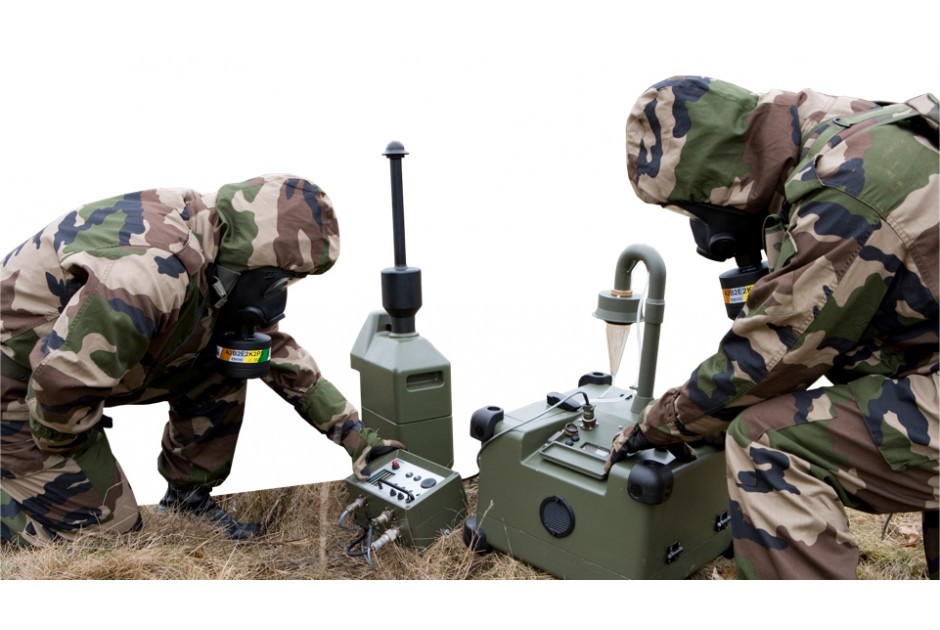ASTM F739 Protective clothing chemical permeation rate determination testing
The ASTM F739 standard provides a method to determine the permeation rates of gases and vapors through protective clothing. This service is crucial for ensuring that personnel in military applications are adequately protected from hazardous chemicals and environments. The test involves exposing samples of the material to specific chemical challenges under controlled conditions, measuring the rate at which these chemicals penetrate the fabric.
The ASTM F739 testing process begins with selecting appropriate specimens of the protective clothing for testing. These specimens are prepared according to standard procedures, ensuring they accurately represent the intended product. The test setup includes a permeation chamber where the specimen is placed and exposed to the chemical challenge. The challenge chemicals are selected based on their relevance to potential military environments and hazards.
During the test, a constant flow of the target chemical is introduced into the permeation chamber. Sensors continuously monitor the concentration of the chemical both inside and outside the specimen. By measuring the change in concentration over time, the rate at which the chemical permeates through the material can be calculated. This rate is expressed as milligrams per square meter per hour (mg/m2/h).
The ASTM F739 standard specifies acceptance criteria based on both the permeation rate and the diffusion coefficient of the chemicals used in the test. Compliance with these criteria ensures that the protective clothing meets the necessary standards for chemical resistance.
The expertise required to perform this testing accurately is extensive, as it involves not only understanding the ASTM F739 standard but also having a deep knowledge of the chemical challenges faced by military personnel. This service is tailored to meet the high demand for reliable and accurate protective clothing in sectors where human safety is paramount.
The significance of this test cannot be overstated. It ensures that the equipment used by our armed forces can withstand the rigors of combat and protect against hazardous materials. By adhering strictly to ASTM F739 standards, we provide a critical layer of protection for those who serve. The precision and reliability of these tests are essential in maintaining the highest levels of safety and performance.
The competitive advantage gained from this service is significant. It allows our clients to ensure that their protective clothing meets or exceeds industry standards, thereby gaining a reputation for producing high-quality, reliable products. This can lead to increased market share and customer trust, which are vital in any business environment.
Environmental and Sustainability Contributions
The ASTM F739 testing service contributes positively to environmental sustainability by ensuring that protective clothing is designed with the highest standards of chemical resistance. This reduces the risk of accidental leaks or breaches, which can lead to the unintended release of harmful substances into the environment. By preventing such incidents, we help protect ecosystems and human health.
The test also supports sustainable practices by facilitating continuous improvement in material science. Through rigorous testing, manufacturers can identify areas for enhancement and innovation, leading to more effective and eco-friendly protective clothing. This not only benefits the immediate users but also contributes to broader environmental goals.
Our commitment to sustainability is further enhanced by our adherence to international standards such as ISO 14001 for environmental management systems. By aligning with these standards, we ensure that all aspects of our operations are conducted in an environmentally responsible manner.
Competitive Advantage and Market Impact
- Innovation Leadership: Our expertise in ASTM F739 testing allows us to stay at the forefront of chemical protection technology. This enables us to offer innovative solutions that meet or exceed current standards, providing a significant competitive edge.
- Trust and Reputation: By ensuring compliance with ASTM F739 standards, we build trust among our clients and partners. This reputation for reliability can significantly enhance market positioning and customer loyalty.
The market impact of this service is substantial. It allows companies to differentiate themselves in a crowded industry by offering products that are not only effective but also compliant with the highest international standards. This differentiation can lead to increased sales, better relationships with clients, and enhanced brand perception. The service also supports long-term business growth through the continuous improvement of product offerings.
Use Cases and Application Examples
- Military Personnel: ASTM F739 testing is essential for ensuring that protective clothing used by military personnel can withstand hazardous environments, such as chemical warfare scenarios. This ensures the safety of soldiers in high-risk situations.
- Hazardous Material Workers: The test is also crucial for workers handling and transporting dangerous chemicals. It helps ensure that their protective gear provides adequate protection against accidental exposure.
In addition to these primary use cases, ASTM F739 testing can be applied in various other scenarios where chemical resistance is critical. For example, first responders during emergencies, industrial workers in petrochemical plants, and even astronauts requiring extravehicular activity suits must have protective clothing that meets the stringent requirements set by this standard.





